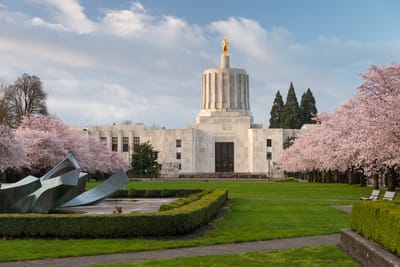
Oregon’s Statewide Land Use Planning Goals
Oregon’s passage of SB 100 in 1973 established a statewide land use planning system. The system is founded on nineteen Statewide Land Use Planning Goals. All local Comprehensive Plans must be consistent with the Goals, but once a local Comprehensive Plan is adopted it becomes the controlling document for land use in that area. Although mostly setting generally policy and not binding requirements, the Goals are implemented through state statutes and regulations, some of which can bind local governments in certain ways in their land use decisionmaking.
The history and evolution of Oregon’s statewide land use planning system is fascinating, and was covered in the OPB series “Growing Oregon,” available to listen to or read here.
A summary of the goals is available here. The nineteen goals are:
- This goal requires public participation in land use decisions, including the requirement for the local decision-maker to provide information and the opportunity to comment on land use decisions.
Goal 2 Land Use Planning
Goal 3 Agricultural Lands
- This goal and its implementing regulations limit uses and conversion of agricultural lands.
Goal 4 Forest Lands
- This goal and its implementing regulations limit uses and conversion of forest lands.
Goal 5 Natural Resources, Scenic and Historic Areas, and Open Spaces
Goal 6 Air, Water and Land Resources Quality
Goal 7 Areas Subject to Natural Hazards
Goal 8 Recreational Needs
Goal 9 Economic Development
Goal 10 Housing
Goal 11 Public Facilities and Services
Goal 12 Transportation
Goal 13 Energy Conservation
Goal 14 Urbanization
- LCDC’s Rural Residential Rule (OAR 660-004-0040) specifies how Goal 14 applies to rural lands in acknowledged exception areas planned for residential uses (i.e. lands planned and zoned for residential uses where an exception to Goals 3 and/or 4 have already been taken). Under this Rule, any new lot or parcel smaller than 2 acres in a rural residential zone is considered an urban use and would require an exception to Goal 14.
Goal 15 Willamette River Greenway
Goal 16 Estuarine Resources
Goal 17 Coastal Shorelands
Goal 18 Beaches and Dunes
Goal 19 Ocean Resources
State Land Use Statutes & Rules
Statutes
The following are the major statutes governing land use planning. These statutes (known as “Oregon Revised Statutes” or ORS) are the source of many minimum requirements that local codes must satisfy, but may exceed.
- ORS 197 – Comprehensive Land Use Planning I
- ORS 215 – County Planning, Zoning, Housing Codes
- ORS 215.283–Uses allowed on farmland.
- ORS 227 – City Planning and Zoning
- full list of ORS chapters relevant to land use planning.
Rules
These rules (known as “Oregon Administrative Rules” or OAR) implement the state goals and statutes, and provide more detailed requirements for local land use planning. Below are some highlights of rules that may be important to review in assessing a local land use decision:
- OAR 660 – Rules developed by the Land Conservation and Development Department (LCDC)
- OAR 660-004: This rule sets standards for when and how a local government can grant an exception for a land use application that does not meet the minimum requirements of a certain Statewide Land Use Planning Goal.
- OAR 660-014: Standards for allowing urban development on rural lands.
- OAR 660-004-0040: Known as the “rural residential rule,” this rule governs urbanization of rural lands that have already been granted an exception from Goals 3 or 4.
- OAR 660-033-0120: Uses authorized on agricultural lands
- OAR 661––Governs LUBA appeals and decisions
- full list of OARs relevant to land use planning.
State Land Use Agencies
Oregon Land Conservation and Development Commission (LCDC): LCDC adopts state land use goals and implements rules, reviews local compliance with the goals, and coordinates state and local planning.
Oregon Department of Land Conservation and Development (DLCD): The Department of Land Conservation and Development (DLCD) is housed within LCDC and implements the statewide planning program in various ways. DLCD works with local governments on their land use planning programs. DLCD reviews changes to comprehensive plans and other land use decisions for compliance with state rules, and may appeal decisions to LUBA. DLCD has Regional Representatives who serve as a resource for local communities on Oregon’s land use rules and regulations.
